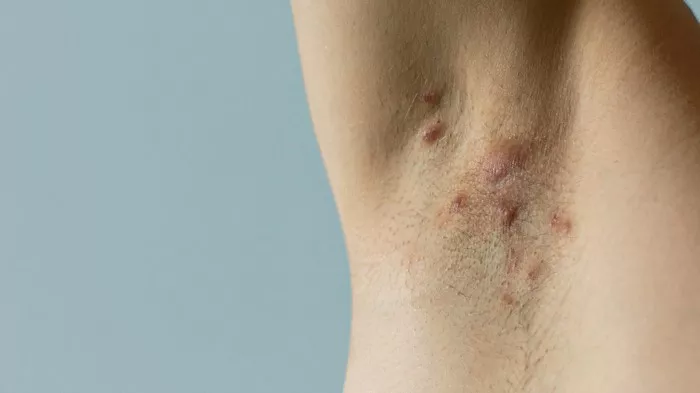Hidradenitis suppurativa (HS) is a chronic inflammatory skin condition characterized by painful nodules, abscesses, and sinus tracts primarily affecting the intertriginous areas of the body, such as the axillae, groin, and perineum. The management of HS often involves a multifaceted approach aimed at reducing inflammation, preventing infection, and promoting wound healing. While antibiotics play a crucial role in the treatment of HS, their use must be guided by a thorough understanding of the underlying pathophysiology and individual patient characteristics.
Understanding the Pathophysiology of Hidradenitis Suppurativa
The exact etiology of HS remains incompletely understood; however, it is believed to involve a combination of genetic predisposition, hormonal factors, immune dysregulation, and environmental triggers. HS is characterized by follicular occlusion, leading to the formation of inflammatory nodules, abscesses, and sinus tracts. Bacterial colonization, particularly with anaerobic organisms such as Cutibacterium acnes and Staphylococcus aureus, further contributes to the inflammatory process and exacerbates disease severity.
The Role of Antibiotics in Hidradenitis Suppurativa Management
Antibiotics are a cornerstone of HS treatment due to their ability to target bacterial overgrowth within affected skin lesions. While systemic antibiotics are commonly used in the management of HS, their efficacy varies depending on the severity of the disease, the presence of bacterial colonization, and individual patient factors. The goals of antibiotic therapy in HS include reducing inflammation, preventing infection, and promoting wound healing.
Types of Antibiotics Used in Hidradenitis Suppurativa
1. Tetracyclines: Tetracyclines, such as doxycycline and minocycline, are frequently used as first-line antibiotics in the treatment of HS due to their anti-inflammatory and antimicrobial properties. These agents inhibit bacterial protein synthesis and modulate inflammatory pathways, leading to a reduction in lesion severity and frequency. Tetracyclines are often prescribed at sub-antimicrobial doses to minimize adverse effects such as gastrointestinal upset and photosensitivity.
2. Clindamycin: Clindamycin is a lincosamide antibiotic with excellent activity against anaerobic bacteria commonly implicated in HS pathogenesis. Topical clindamycin formulations are often used as adjunctive therapy for mild to moderate HS, either as monotherapy or in combination with oral antibiotics. However, the emergence of bacterial resistance underscores the importance of judicious antibiotic use and combination therapy strategies.
3. Rifampicin: Rifampicin is a potent antibiotic with activity against a wide range of Gram-positive and Gram-negative bacteria, including Staphylococcus aureus. When used in combination with another antibiotic, such as clindamycin or doxycycline, rifampicin has demonstrated efficacy in reducing lesion severity and promoting wound healing in patients with refractory HS. However, prolonged use of rifampicin should be avoided due to the risk of bacterial resistance and hepatotoxicity.
4. Macrolides: Macrolide antibiotics, such as erythromycin and azithromycin, possess both anti-inflammatory and antimicrobial properties, making them attractive options for HS treatment. These agents inhibit bacterial protein synthesis and modulate immune responses, leading to a reduction in lesion inflammation and bacterial burden. Macrolides are particularly useful in patients with penicillin allergies or intolerance to tetracyclines.
5. Trimethoprim-sulfamethoxazole (TMP-SMX): TMP-SMX, also known as co-trimoxazole, is a combination antibiotic commonly used to treat skin and soft tissue infections caused by Gram-positive and Gram-negative bacteria. In HS management, TMP-SMX is often prescribed for its anti-staphylococcal activity and ability to penetrate skin and soft tissue lesions. However, its use may be limited by adverse effects such as gastrointestinal upset, hypersensitivity reactions, and hematologic abnormalities.
Antibiotic Resistance and Treatment Considerations
The emergence of antibiotic resistance poses a significant challenge in the management of HS and underscores the need for judicious antibiotic prescribing practices. Prolonged or indiscriminate use of antibiotics can promote bacterial resistance, leading to treatment failure and disease recurrence. To mitigate this risk, healthcare providers should adhere to evidence-based guidelines and employ combination antibiotic therapy when appropriate. Additionally, patients should be counseled on the importance of medication adherence and the potential consequences of antibiotic misuse.
Combination Therapy Approaches
Combination therapy involving antibiotics with different mechanisms of action is often employed in the management of refractory HS to enhance efficacy and minimize the development of antibiotic resistance. For example, the combination of rifampicin and clindamycin has been shown to be effective in reducing lesion severity and improving patient outcomes in individuals with severe or recalcitrant HS. Similarly, the combination of systemic antibiotics with topical agents such as benzoyl peroxide or retinoids may provide synergistic benefits by targeting both bacterial colonization and follicular occlusion.
Conclusion
Antibiotics play a critical role in the management of hidradenitis suppurativa by targeting bacterial overgrowth, reducing inflammation, and promoting wound healing. However, their use should be guided by a comprehensive understanding of the underlying pathophysiology, disease severity, and individual patient factors. Healthcare providers should strive to balance the benefits of antibiotic therapy with the potential risks of antibiotic resistance and adverse effects, employing evidence-based treatment strategies to optimize patient outcomes in HS management.
Related Topics:



























